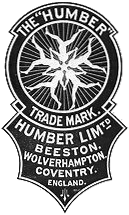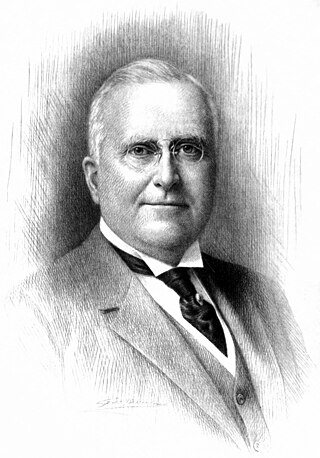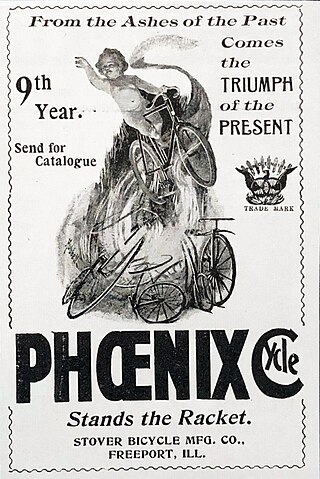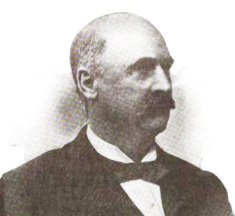Falcon Cycles is a British bicycle manufacturer which was based in Brigg, North Lincolnshire, owned by Tandem Group.

Marshall Walter "Major" Taylor was an American professional cyclist. Even by modern cycling standards, Taylor could be considered the greatest American sprinter of all time.

Albert Augustus Pope was a Brevet Lieutenant-Colonel in the Union Army. He was an importer, promoter, and manufacturer of bicycles, and a manufacturer of automobiles.

Humber Limited was a British manufacturer of bicycles, motorcycles, and cars incorporated and listed on the stock exchange in 1887. It took the name "Humber & Co Limited" because of the high reputation of the products of one of the constituent businesses that had belonged to Thomas Humber. A financial reconstruction in 1899 transferred its business to Humber Limited.

Sterling Bicycle Co. was a 19th-century American bicycle company first based in Chicago, Illinois before relocating to Kenosha, Wisconsin.
Pope Manufacturing Company was founded by Albert Augustus Pope around 1876 in Boston, Massachusetts, US and incorporated in Hartford, Connecticut in 1877. Manufacturing of bicycles began in 1878 in Hartford at the Weed Sewing Machine Company factory. Pope manufactured bicycles, motorcycles, and automobiles. From 1905 to 1913, Pope gradually consolidated manufacturing to the Westfield Mass plant. The main offices remained in Hartford. It ceased automobile production in 1915 and ceased motorcycle production in 1918. The company subsequently underwent a variety of changes in form, name and product lines through the intervening years. To this day, bicycles continue to be sold under the Columbia brand.

American Bicycle Company (1899-1903) was an American bicycle company (Trust) led by Albert Augustus Pope. The company was formed to consolidate the manufacturers of bicycles and bicycle parts. In the 1890s the advancements in bicycle design led to unprecedented demand for the new Safety bicycles. The "American Bicycle Company" trust only lasted for three years.
The history of the motorcycle begins in the second half of the 19th century. Motorcycles are descended from the "safety bicycle," a bicycle with front and rear wheels of the same size and a pedal crank mechanism to drive the rear wheel. Despite some early landmarks in its development, the motorcycle lacks a rigid pedigree that can be traced back to a single idea or machine. Instead, the idea seems to have occurred to numerous engineers and inventors around Europe at around the same time.

Humber is an English brand of bicycle. Thomas Humber made himself a velocipede in 1868. From that time he built a substantial business in manufacturing tricycles and bicycles while continuously improving their design and construction. His products were so well-made and well-designed they were known as "the aristocrat among bicycles".
The Bundy Manufacturing Company was a 19th-century American manufacturer of timekeeping devices that went through a series of mergers, eventually becoming part of International Business Machines and Simplex Time Recorder Company. It was the first time-recording company in the world to produce time clocks, colloquially known as 'Bundys'. The company was founded by the Bundy Brothers.

The Gladiator Cycle Company, Clément-Gladiator, was a French manufacturer of bicycles, motorcycles and cars based in Le Pré-Saint-Gervais, Seine.

Overman Wheel Company was an early bicycle manufacturing company in Chicopee Falls, Massachusetts from 1882 to 1900. It was known for bicycles of higher quality and lower weight than other bicycles of its time. Despite a nationwide bicycle craze in the late 1800s, the company was undercut by lower-priced competition, nearly went bankrupt in 1897, and never recovered from an 1899 fire. The company was sold in 1900.
Arthur Calvin Newby was an American businessman and pioneer of the bicycle and automotive industries in Indianapolis, Indiana. He was best known as one of the founders of the Indianapolis Motor Speedway.

Western Wheel Works was a Chicago bicycle company started by Adolph Schoeninger in 1866. It was one of the largest bicycle makers in the world. In 1899 it joined a trust which controlled 95 percent of the bicycle manufacturing market.

Indiana Bicycle Company was a bicycle and automobile company in Indianapolis, Indiana, United States. The company made carriages, bicycles and electric vehicles under the name Waverley Cycles. By 1896 the company was producing 350 bicycles every ten hours.

John William Kiser was a 19th-century industrialist who owned the Monarch Cycle Manufacturing Company in Chicago, Illinois. His company became one of the largest bicycle manufacturers in the world.

Stover Bicycle Manufacturing Company was a bicycle manufacturer in Freeport, Illinois founded by D.C. Stover. The company produced 20,000 bicycles a year in 1897.

D.C. Stover was a 19th-century industrialist who was known for founding the Stover Wind Engine Company, the Stover Manufacturing and Engine Company, the Stover Bicycle Manufacturing Company and the Stover Engine Works. He was considered to be one of the wealthiest man in Freeport Illinois.

Indianapolis Chain and Stamping Company also known as Diamond is a company based in Indianapolis, Indiana. At one time they supplied bicycle chains for the majority of bicycles produced in the United States.















